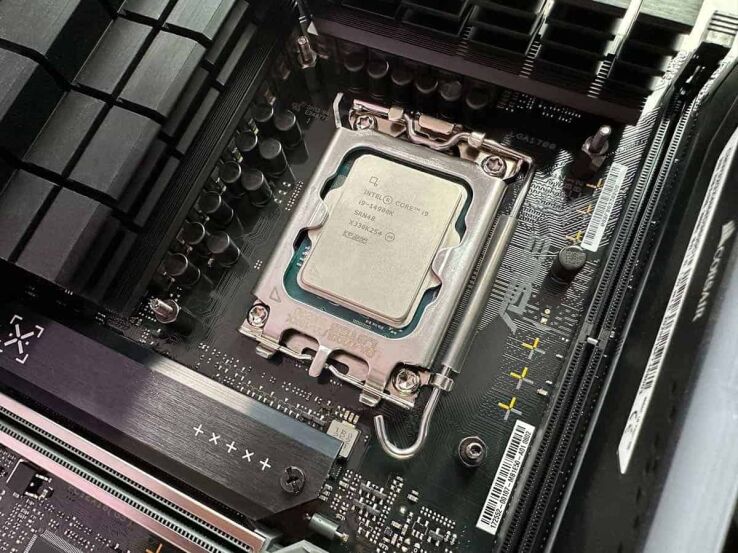Intel Core i9 14900K specs – the full breakdown
We examine the Intel Core i9-14900K specifications and discuss what they mean for the performance of this new CPU

WePC is reader-supported. When you buy through links on our site, we may earn an affiliate commission. Prices subject to change. Learn more
The Intel 14th gen release date has come to pass and we now know what the Intel Core i9-14900K specs are, having had them officially confirmed by the boys in blue. If you want to know whether or not this new Intel flagship is worth your money, have a look at our Intel Core i9-14900K review for benchmarking and an in-depth assessment of its price/performance. If however you’re just interested in the specs, then read on!
Below we list the Intel Core i9-14900K specifications and explain what each of the different specs means. If you’re looking to see how this measures up to the competition, check out our 14900K vs 7950X3D page, or see our 14900K vs 13900K page to see how the specs and pricing compare to the previous generation.
Intel Core i9-14900K
Core configuration:
24 (8+16)
Threads:
32
P-Core Speed:
5.8GHz (boost) 3.2GHz (base)
E-Core Speed:
4.4GHz (boost) 2.5GHz (base)
DDR5 support:
Yes @ 5600MHz
TDP
125W base 253W PL1 & PL2
Intel Core i9-14900K specifications
| Specifications | Intel Core i9-14900K |
|---|---|
| Process size | 10nm |
| Die size | 257mm² |
| No. of cores | 24 |
| No. of threads | 32 |
| P-Cores | 8 |
| E-Cores | 16 |
| P-Core Frequency | 3.2GHz (base) / 5.8GHz (boost) |
| E-Core Frequency | 2.5GHz (base) / 4.4GHz (boost) |
| TDP | 125W – 253W |
| Release date | 17th Oct, 2023 |
| Launch price | $599 |
i9-14900K specs, source: Intel
Process size
The process size is essentially the measurement of how small the constituent components are on a microchip, specifically the smallest possible element. The smaller the process size, the more transistors can be fit on the same size chip, and the more efficient/powerful a chip can become.
The process size of the Intel 14th gen processors remains the 10nm that was used in the previous Intel 13th gen Raptor Lake line. This is considerably larger than AMD’s latest 5nm Zen 4 process size, but through making larger chips and leveraging other technology, the Intel processors can still be more powerful, even if they’re less energy efficient.
Die size
This represents the area taken up by the physical dimensions of the brain of the chip, not including any external housing or chassis of the CPU (which is sometimes called the I/O die size). For comparison the Ryzen 9 7950x3D die size is only 71mm², with the actual I/O die size being 122mm². This shows the benefit of the smaller process size on the AMD chips.
Cores & Threads
Cores are the physical units that compose the CPU itself. These are divided into threads, which are essentially ‘virtual’ cores than enables one physical core to process multiple tasks simultaneously. Intel chips of the last couple of generations now have two types of cores: P-cores (aka performance cores) and E-cores (aka efficiency cores). The former type are the most powerful, used for more intensive tasks and the efficiency cores are less powerful, but better suited to less-demanding tasks because they use less power – the whole setup is design to increase efficiency.
Base/Boost Frequency
The base frequency is the typical clock speed of a processor core when doing non-demanding tasks. The boost/turbo frequency represents the maximum clock speed it is capable of during demanding tasks, and is the true representative of the power of the processor for most scenarios. The 5.8GHz boost frequency on the P-cores is the highest currently available in any CPU, and beats the 5.7GHz result of the AMD Ryzen 9 7950X3D, indicating that the single-core performance (important for gaming) should be superior on the Intel chip. Overclocking the processor can increase this boost speed at the expense of stability and greater thermal output.
TDP
This is essentially the power draw of the CPU. The base TDP value (125W in this case) represents the bare minimum power that the processor will draw, even when idling. The higher value represents the power draw when the CPU is going full-throttle. Generally the base TDP for Intel 14th gen processors is pretty reasonable, but the higher boost value (253W) is considerably higher than the AMD Ryzen range (which caps out at 181W) . These are power-hungry processors and as a result you may need to spend more on a more powerful power supply (PSU) if you want to buy one of these, particularly if you’re thinking about overclocking which will increase the TDP even further – have a read of our best PSU for gaming for some examples.
Intel Core i9-14900K specs – Final Word
We trust you now know everything you need to on the subject of the Intel Core i9-14900K specs. For more CPU info, do be sure to check out our best CPU for gaming page, and if you fancy picking one of these bad boys up, take a look at our where to buy Intel Core i9-14900K pre order guide.